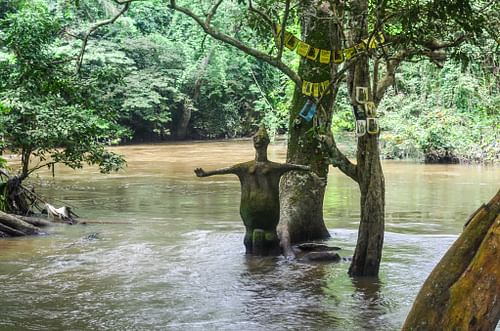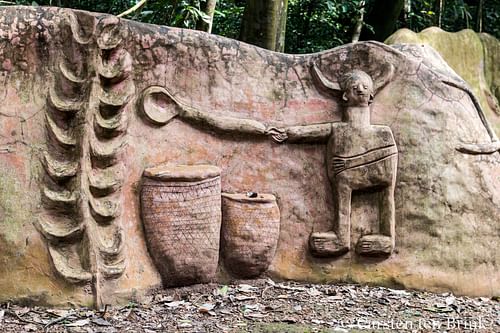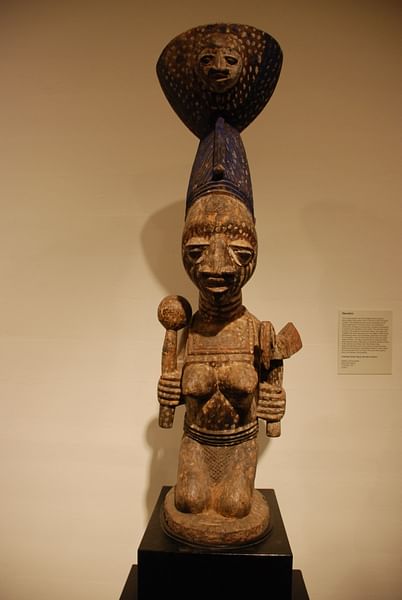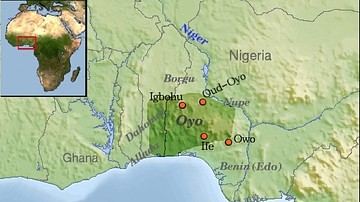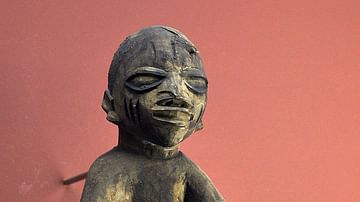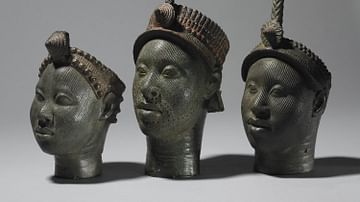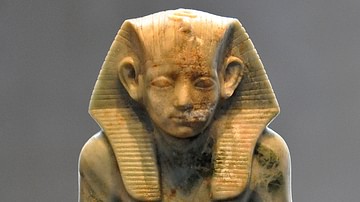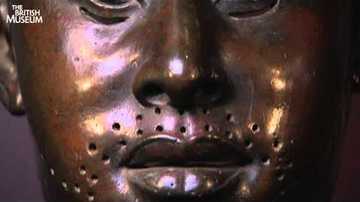
Oshun (pronounced O-shan, also given as Osun) is a supernatural entity recognized as both a spirit and a goddess in the Yoruba religion of West Africa. She presides over fertility, love, and freshwater, is the patroness of the Osun River in Nigeria, and is honored annually at the Osun-Osogbo Festival.
Oshun is one of the 400+1 Orishas (also given as Orisa) avatars of the supreme deity Olodumare (also given as Olodumare-Oloorun) who created and is the universe. According to some accounts, she is the favorite of Olodumare – a force neither male nor female and referred to as "they" or sometimes "it" – and the only one welcomed in delivering messages to the realm of Orun, the deity’s sphere.
She is both a creative and destructive force, but her floods or droughts are recognized as a response to the actions of people who fail to honor her or the land with proper respect. Oshun is especially attentive to women, those seeking meaningful relationships, pregnant women, or those hoping to become pregnant. She is also invoked by women and men for luck, health, strength during times of challenge and change, and prosperity.
She was exported to the New World during the African Diaspora where she came to be known by many different names in the Caribbean, South, Central, and North America when Yoruba people were sold there as slaves. The Yoruba religion continued to be practiced by syncretizing it with Christianity, and she remains an important figure in the systems of Santeria, Vodou, and Candomblé. She is counted among the great fertility goddesses of world culture along with figures such as Aphrodite, Freyja, Frigg, Venus, Sauska, Astarte, and others and has become an increasingly popular goddess among women as a source of self-empowerment.
Olodumare & Orishas
The Yoruba religion developed in the region of modern-day Nigeria c. 300 BCE around the city known as Ife (also Ile-Ife) which flourished between the 11th and 15th centuries CE. Ife was considered the place of divine creation where Orisha-Obatala separated the waters from land and established life on earth. Another version of the story has the Orisha Oduduwa as creator of both earth and the Yoruba people. Oduduwa remained an important deity at Ife, known as its first king, and his children were sent from the city to rule in other places, establishing the concept of monarchy and cultural identity. Oduduwa is usually referred to as a god, as are the other Orishas, all of whom serve the same purpose as deities in any religion.
Orishas are aspects of the supreme state of existence and divine creator Olodumare who, like the figure of Brahman in Brahmanism and Hinduism, is too impossibly powerful and immense to be comprehended by the human mind. Their number is given as 400+1 to suggest they cannot be numbered. Any attempt at defining them by number will always require a +1, and so they are infinite, although only between seven and twenty regularly appear in stories.
Olodumare maintains close contact with his creation through his Orishas, avatars, to whom he gave various powers by casting these into the air and, whichever Orisha caught a certain power, was responsible for wielding it. In this way, the Orisha Shango (also given as Chango) became god of lightning, fire, and virility, Yemaya the mother of waters and women, Esu (also given as Eshu, the trickster god) the lord of doorways, gates, crossroads, and messages, and so on.
Although the Orishas were aspects of the single expression of existence, they were also autonomous beings with their own personalities, desires, and failings. They could become jealous, depressed, angry, and be spiteful, just as humans were, and even periodically came up with schemes to rebel against Olodumare and reign in their place. Olodumare was always informed of their plans by Esu, their messenger, and was able to calmly deal with the situation and direct the Orishas back to their individual responsibilities concerning the world and human life.
Oshun as Creator & Destroyer
The one Orisha who is never mentioned among these plots is Oshun. She is the youngest of the Orishas and is either the daughter of Yemaya or her younger sister according to different versions of her story. At the beginning of creation, after Obatala was done with the initial work, Olodumare sent 17 Orishas to earth to set things in order and bring Obatala’s (or Oduduwa’s) work to completion. 16 of these were males, and the seventeenth was Oshun.
The males ignored her suggestions on how to make life beautiful, meaningful, and sweet, failing in their mission. They were forced to humble themselves and return to Olodumare with the bad news and were asked where the seventeenth Orisha was. When they admitted to ignoring her, they were told they could not complete the work without her and so again had to humble themselves and ask her forgiveness. Oshun gave the world love, fertility, and beauty, instilling the need for these things in all people, and so creation was completed.
At this time, Oshun had no realm of her own, however, unlike the other Orishas, because she was so young. Shango was lord of fire and lightning, Obatala lord of the sky, Ogun of metallurgy, and all the other Orishas had their own sphere of influence. Oshun was wandering the world one day when her beauty was noticed by Ogun, who pursued her. In her flight from him, she slipped into a river and was whirling away downstream when Yemaya saw and rescued her, giving her the gift of sweet water and rivers as her realm so she would always have a safe place to call home. Afterwards, although Yemaya remained the mother of waters, Oshun presided over freshwater and, specifically, the Osun River.
Sometime after this (or before, depending on different accounts), the Orishas again became dissatisfied with Olodumare as the supreme being, as they had before, and felt they could do a better job running the world. Esu brought the supreme being the news that the Orishas would no longer obey and so Olodumare stopped the rainfall. A great drought took the land, streams, rivers, and lakes were drying up, and the earth began to die. The Orishas recognized they had angered Olodumare and cried out for forgiveness, but Olodumare could not – or would not – hear them.
Oshun turned herself into a peacock and took flight for Orun, high in the heavens, to bring the news of the Orishas’ repentance to Olodumare. The journey was long, however, and she had to pass closely by the sun to reach Orun, which tarnished her feathers and caused her to lose many. She continued, despite her exhaustion, and fell into the arms of Olodumare at last in the form of a vulture. Olodumare was impressed by her courage, determination, and sacrifice and so healed her, released the rains upon the earth, and designated Oshun as the only Orisha always welcome to deliver messages to Orun from that time forward. The peacock and vulture came to be associated with her from this tale.
Although she had participated in the creation of the world and had also saved it from extinction, she is also depicted as destroying life when humans offend her through their carelessness, cruelty, and lack of respect for the divine and the natural world. As the divinity of freshwaters, she can withhold rain to cause drought or send unending deluge to flood the land and wash away those who displeased her. Oshun’s actions are always in response to some sin of the people, and she plays no part in the Yoruba version of the Great Flood story in which the Orisha Olokun (who presided over the sea) floods the world with ocean water in anger over Obatala taking too much land as part of the act of creation.
Characteristics, Marriage, & Associations
Aside from her periodic outbursts, Oshun is depicted as kind, benevolent, and merciful. One story relates how a people who settled by the Osun River near the city of Osogbo disrespected her simple requests and were washed away but another, who came later, respected and honored her. In return, Oshun promised them her protection, guidance, and providence, allowing Osogbo to flourish. The city came to be associated with Oshun and was considered a sacred place of pilgrimage. The Osun-Osogbo Festival is still held annually in her honor during which people come from all over to pay their respects at the Osun-Osogbo Sacred Grove outside the city.
Oshun is understood to have kept her promise to the first people who honored her at the site by tending to modern-day pilgrims in healing their infirmities and illnesses, granting fertility and healthy births, and helping people with their various challenges in life. She is understood as a deity especially sympathetic to the difficulties of transitions and is associated with transformation and the struggles associated with change or loss and so she also offers comfort to believers who are grieving as well as those trying to move on and establish a new life.
At the same time, however, Oshun is a distinct personality and is capable of behaving badly just like any human, making her that much more relatable. She is the second wife of Shango, the first being Oba (Orisha of domesticity, time, and the Oba River) and the third Oya (Orisha of rebirth, transformation, and the Niger River). In one story, Oshun becomes jealous of Oba, who has asked her how to make a special dish for Shango. Before preparing the meal, Oshun binds her head in a scarf, covering her ears. She then adds a kind of mushroom that looks like an ear to the dish she is preparing and serves it to Shango who enjoys it. Oba, thinking Oshun cut off her ear to make the meal, cuts off her own in preparing it the next time and serves it to Shango, who is disgusted and rejects the dish. Oshun and Oya then laugh at Oba’s expense.
This story humanizes Oshun, who is usually associated with noble acts, light, brightness, goodness, and generosity, by showing how even the best can behave badly and so encouraging people to forgive themselves for failings. She is associated with the peacock as a symbol of transformation, with the vulture linked to death, rebirth, intelligence, and determination, skunks as symbols of self-determinism and protection, otters in playfulness and joy, and butterflies and bees both linked to fertility, happiness, and change.
Oshun’s identification as an entity who assists with transformative states is limitless and includes, but is not limited to, women’s reproductive health, digestive health, spiritual and mental health, as well as men’s challenges with the same. She was among the most popular deities of West Africa for her universal appeal, and this traveled with her when her people, unwillingly, were brought across the ocean to the so-called New World.
Oshun in the New World
The Transatlantic Slave Trade of the 16th-19th centuries brought millions of enslaved Africans to the Americas and the Caribbean, with the largest populations located in Brazil, Haiti, and Colonial America which then became the United States. By the 18th century, African political powers such as the Kingdom of Benin, the Kingdom of Dahomey, and the Oyo Empire were fully involved in the transport and sale of slaves in West Africa, and many of those herded aboard European ships were Yoruba.
Oshun traveled with them to the New World where she continued to be honored along with the other Orishas. In Catholic Brazil and Haiti, the Yoruba recognized their own paradigm in the construct of Catholicism in that Christian saints were addressed for personal needs who then passed on these requests to God in the same way Orishas acted as intermediaries between the people and Olodumare. In the Protestant United States, she was syncretized with the Virgin Mary. In this way, though nominally Christian, the Yoruba could continue to practice their religion which they knew as Isese (translated as “origin of our traditions”) that informed their culture.
In the Brazilian religion of Candomblé, Oshun became known as Oxum (among other epithets relating to her characteristics) while in the Santeria and Vodun belief systems of the Caribbean she became Ochun. In the United States, she may have been honored through the use of the Abebe, a circular fan associated with Oshun, and most likely rituals observed in slave quarters, though this claim is speculative. In those regions where her worship is known to have continued, she retained her traditional attributes as a fertility goddess and protector of women.
Conclusion
Many women in the present day adopt Oshun as their personal deity, just as women have for centuries. Drawing on the ancient stories about her, devotees note her relevance in an age where people, like the 16 arrogant Orishas, increasingly ignore the values she stands for and insist on doing things their own way at a cost to the earth and each other. Those who seek empowerment from Oshun draw on her energies in pursuing personal and communal change which includes a heightened awareness of oneself and others as worthy of love, respect, and happiness.
These themes informed the 2016 album and film Lemonade by the recording artist Beyonce who drew on Oshun for inspiration and addresses her directly in the song Hold Up. The title of both album and film refers to the old adage, "When life gives you lemons, make lemonade", encouraging people to make the best of any situation, but also reflects Oshun’s color yellow, linking her with light. Beyonce makes this association clear in the film where she is shown in an amber-yellow dress with gold bracelets. Gold is also associated with Oshun’s bright character as is honey which often symbolizes fertility.
The association of the adage with Oshun is also apt as gratitude for what one has, rather than regret over loss or bitterness over lack, is a central value of Oshun worship in which adherents are encouraged to recognize and be thankful for the gifts they have been given. Each year, people from many different countries arrive in West Africa to participate in observances centered on the concept of gratitude in honor of Oshun. In 2005, the Osun-Osogbo Sacred Grove, which forms a part of the area of the festival, was declared a UNESCO World Heritage Site, attracting more attention to the great goddess whose adherents worldwide gratefully acknowledge her gifts of beauty, love, and all that makes life sweet.
